Moths are sometimes imagined in gray dull colors. Many species are brown, gray, or even white.
Pink moths are a rare sight but they exist in high numbers in certain areas around North America, Europe, North Africa, and Asia.
Pink moths have a high presence on the Eastern Coast and in states on the Eastern side of the US.
They are present in both tropical and temperate climates.
Atypical feeding habits are a common particularity among pink moths. For example, many adult pink moths don’t feed at all.
This means they have a short lifespan and they might only be seen a single month per year, typically in the spring or the summer.
Pink moths are known to be very specific when it comes to laying eggs as their caterpillars feed on leaves, herbs, and grasses.
Tree leaves and various herbs such as mint are known to accommodate the caterpillars of pink moths.
These caterpillars might not be pink at all as they come in various colors.
Once they pupate, many moths are seen with pink forewings or mostly pink forewings. Their hindwings tend to have reduced or no pink sections at all.
The following species are pink-dominant or have significant areas of pink coloring across the body or the wings.
Table of Contents
1. Rosy Maple Moth
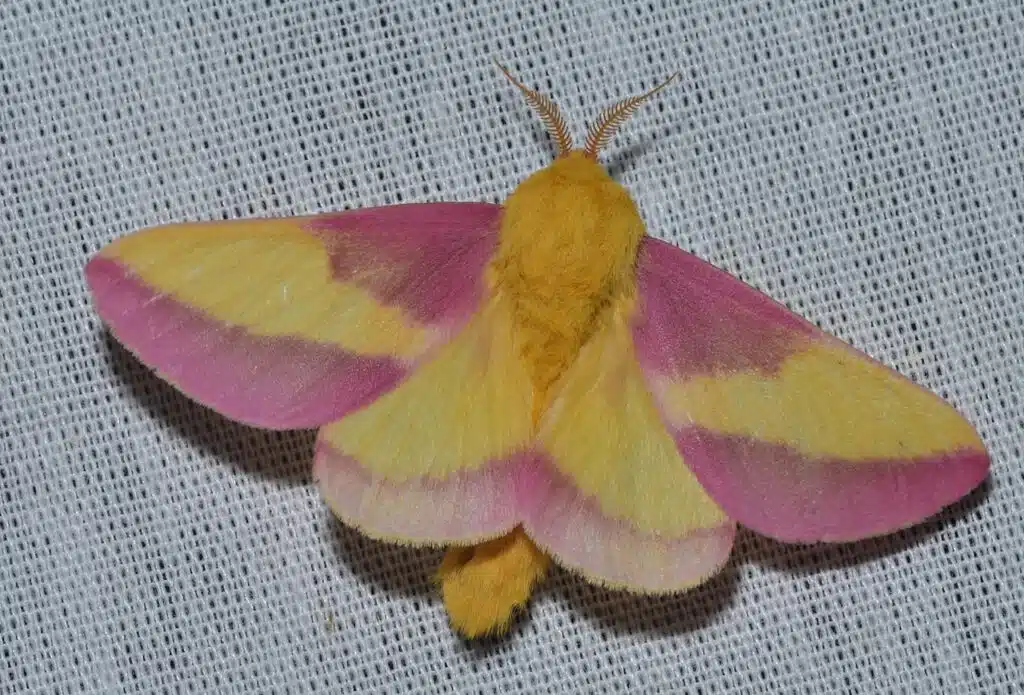
The Rosy Maple Moth (Dryocampa rubicunda) gets its name from its maple tree host. This is where the female lays eggs.
Maple tree leaves are the food for the caterpillars while adult Rosy Maple Moths don’t feed.
Females can also lay moths on nearby trees in the case of overcrowding. Oak trees next to maple trees are sometimes a backup solution for the eggs.
The species has yellow and pink wings, a yellow body, and pink legs.
Rosy Maple Moths are small with varying wingspan measuring between 1 and 2 inches.
2. Primrose Moth
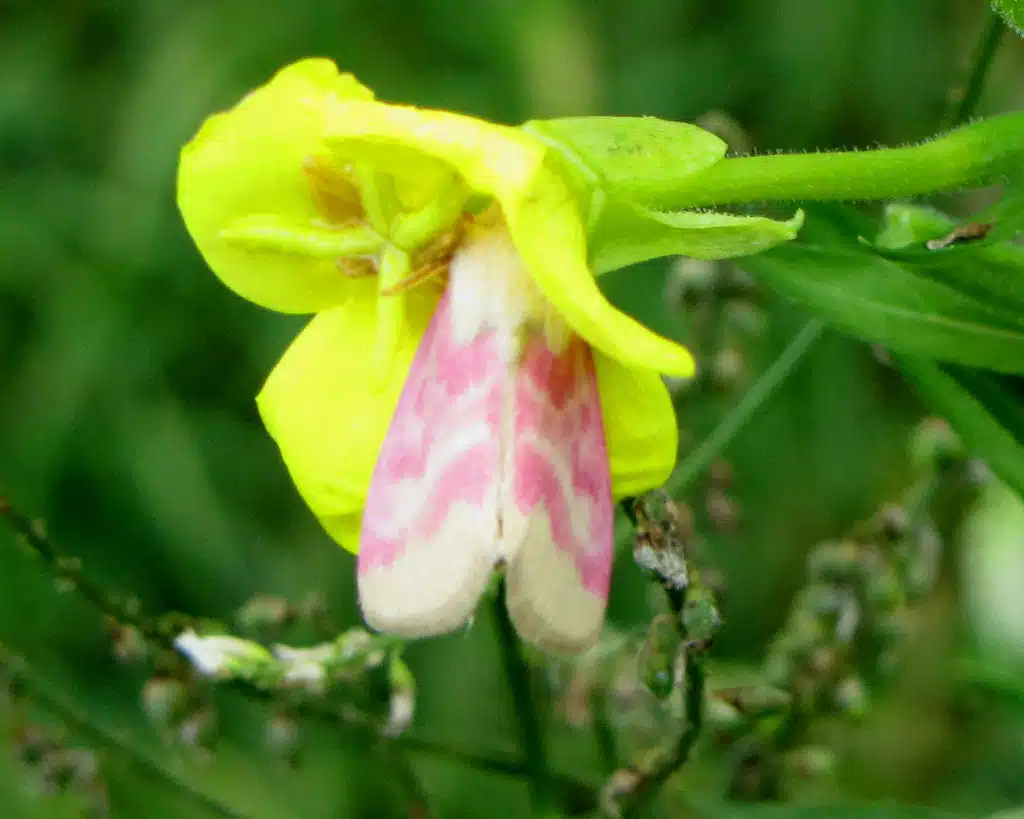
Primrose Moths (Schinia florida) are native to North America. Their highest populations are found in Eastern US states.
Primrose Moths have a combination of pink, cream, and white colors.
Its forewings are mostly pink with cream margins.
Its hindwings lack any pink coloring being purely white. Primrose Moths have pink and cream bodies.
Primrose Moths have similar dorsal and ventral coloring. This species has pink and cream ventral wings.
This is a small moth with a maximum wingspan of 30mm with a nocturnal profile.
Only feeding at night, the Primrose Moth is known for its affinity to evening primrose which inspires its name.
3. Volupial Mint Moth
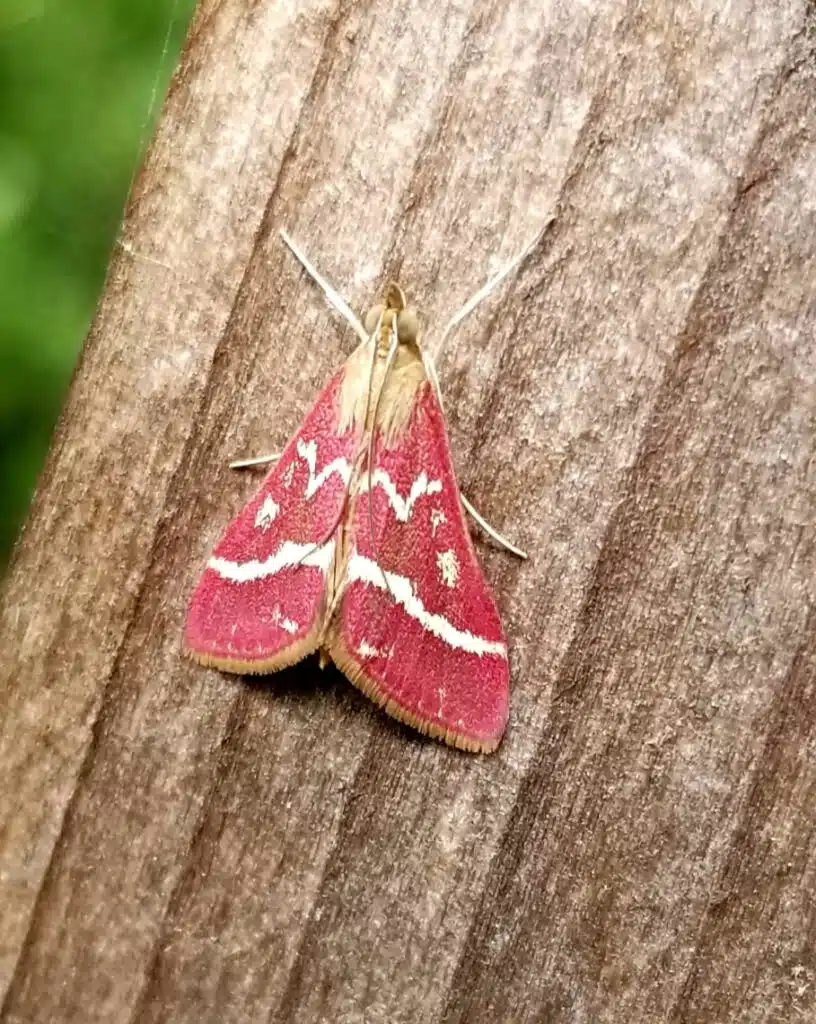
Volupial Mint Moths (Pyrausta volupialis) are some of the smallest pink moths in the country. It measures up to 10.5mm in wingspan.
Its reduced size still allows it to be highly visible as the wings of the species are mostly pink.
This moth has pink wings with yellow lines and marks.
These colors are inherited from the pink, yellow, and green Volupial Mint Moth caterpillar.
As its name implies, the species relies on multiple types of mint for food.
You can find Volupial Mint Moths across California and neighboring states. The moth doesn’t live in Northern or Eastern states.
4. Inornate Pyrausta Moth
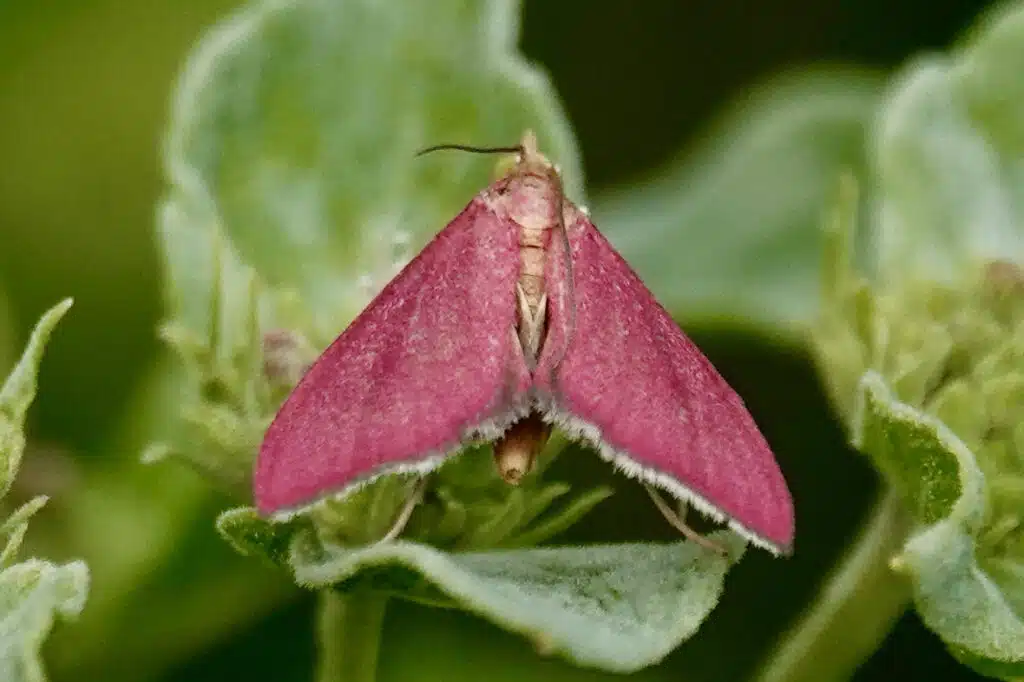
This small moth (Pyrausta inornatalis) is known for its dark shade of pink coloring.
Its wings are almost completely pink. These are dark pink wings which contrast with its yellow body which also shows pink bands.
Found in Southern parts of California, the species can only reach a maximum wingspan of 13mm.
Strays or small populations of Inornate Purausta Moths have been reported Norther in Oregon.
You may find the caterpillars of the species in your garden on salvias.
Its caterpillars have a pale green to blue color with an almost transparent body. Small pink and black dots decorate the entire dorsal side of the caterpillar.
5. Choristostigma roseopennalis
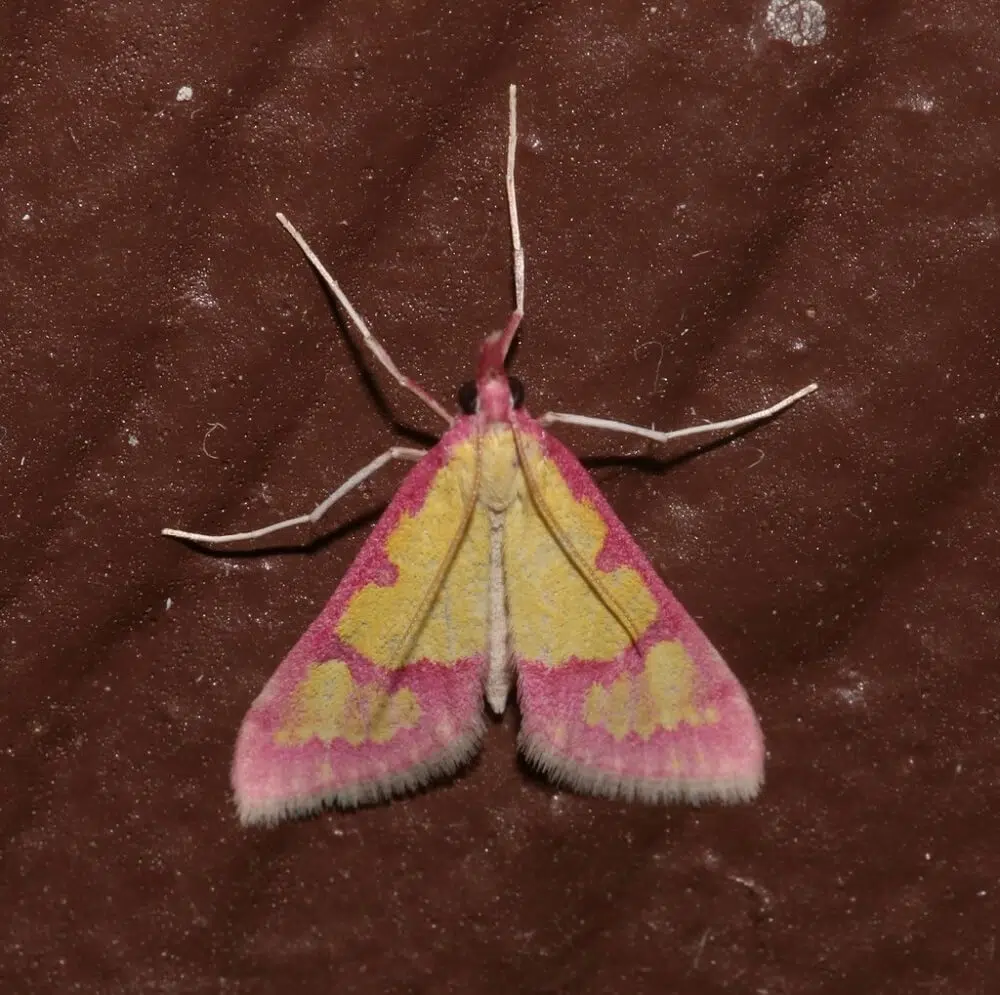
This species of moth is known for having pink sections across its body and forewings.
Its forewings have a cream base color with pink patterns and a pink border on the upper forewings.
White is the main color of its hindwings.
The species has a small size but not as small as other pink moths with a wingspan that can measure up to 18mm.
The presence of this species is concentrated in the Eastern US states.
Moths of this genus are also presence in smaller populations across Southern Texas and Arizona.
6. Pink-striped Oakworm Moth
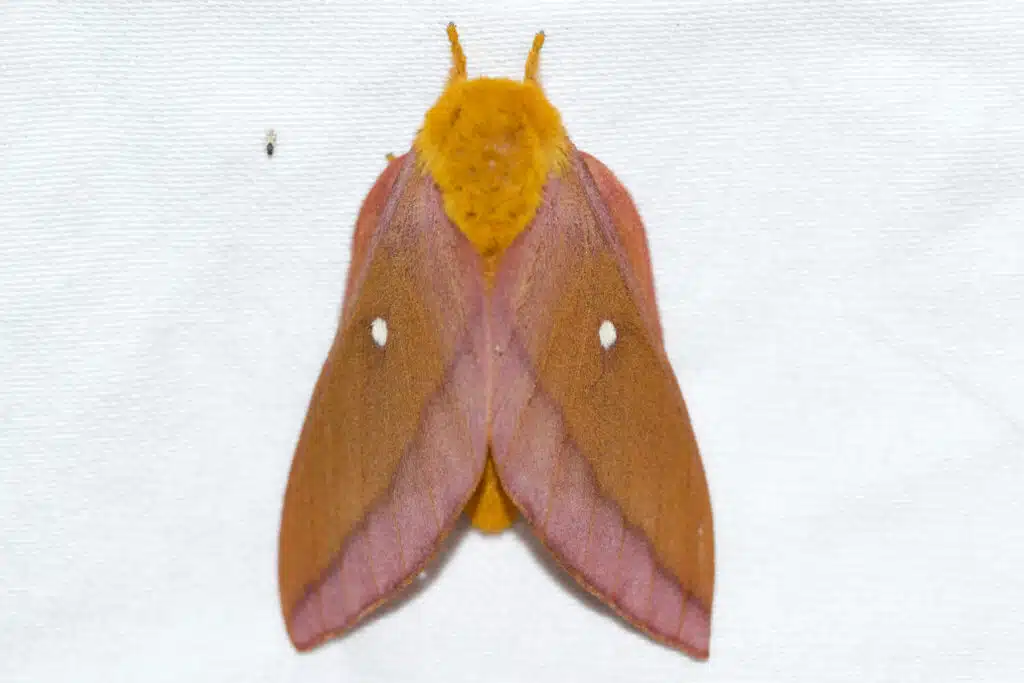
Pink-striped Oakworm Moths (Anisota virginiensis) have multiple pink areas across the wings. The base color of the species is orange-red with pink sections across the forewings.
Only the non-transparent outer sections of the forewings are pink as the inner section is almost completely see-through.
These types of pink moths are seen across various woodlands in North America. Oak woodlands are among the preferred options for the species.
Caterpillars grow on oak leaves.
Adult Pink-striped Oakworm Moths don’t feed.
As a result, this moth species has a very short life. It only lives up to a month, probably from June to July.
7. Raspberry Pyrausta Moth
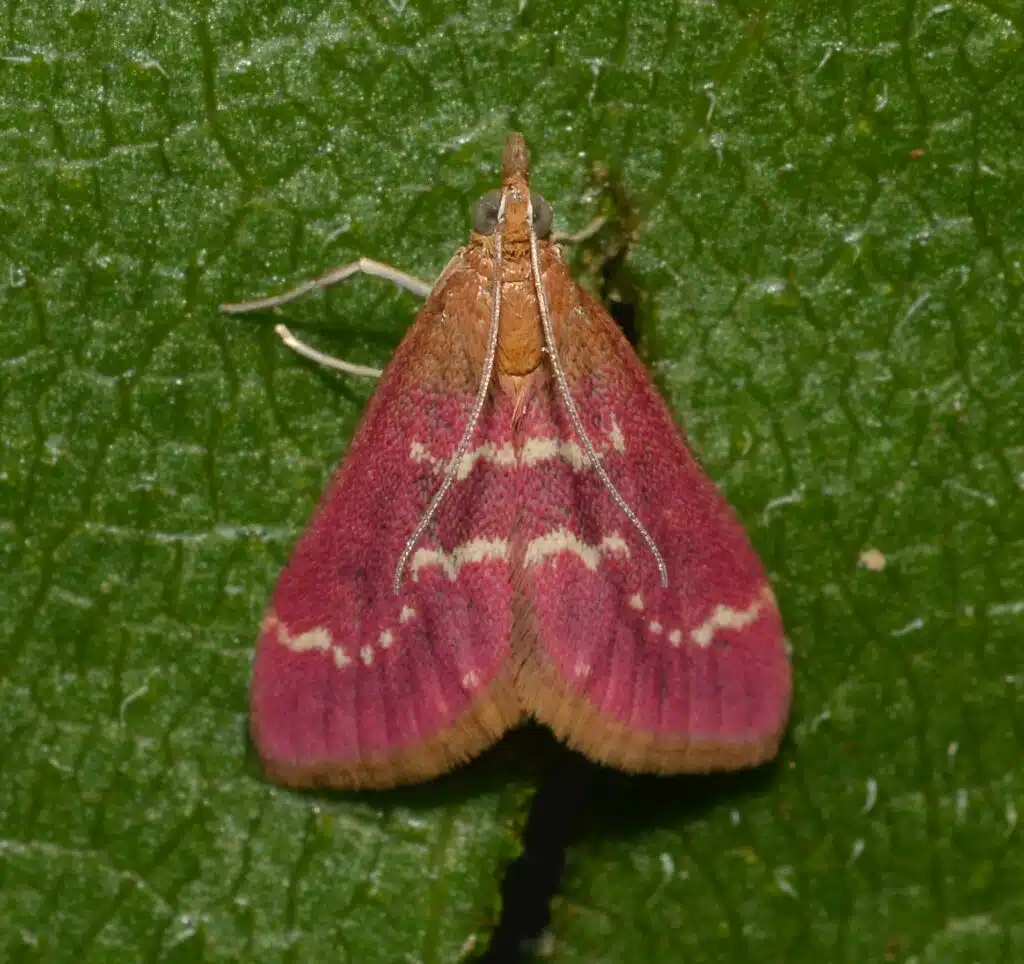
Raspberry Pyrausta Moths (Pyrausta signatalis) are part of a wider group of pink Pyraustas.
They use wild bergamot as host species for their eggs and growing caterpillars.
These wildflowers are typically found close to aspen, a common host of the species.
Fields with short grass are also among the favorite habitats for Raspberry Pyrausta Moths.
This is a small species with a wingspan that measures anywhere between 18 and 22mm. There isn’t much size variation for the species.
Its forewings are mostly pink with yellow stripes.
The hindwings are brown, as is its body.
8. Elephant Hawkmoth
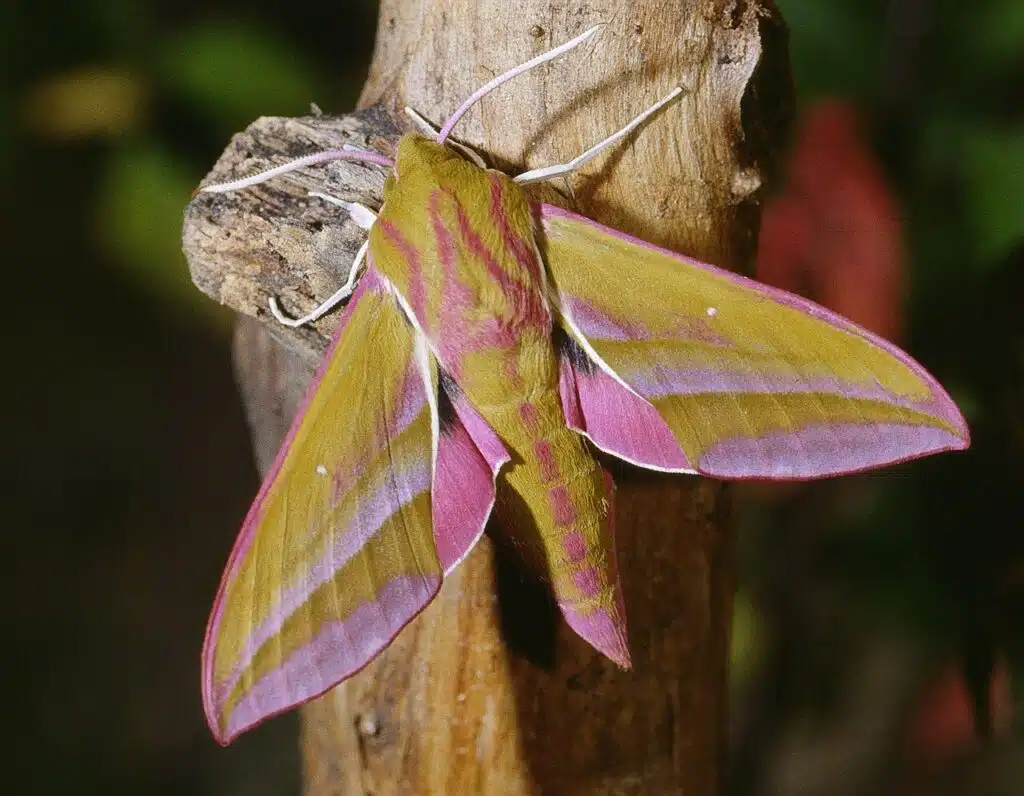
This colorful species (Deilephila elpenor) has pink, brown, black, and white coloring.
Its upper body is pink while its lower body is brown and pink.
The forewings of the species are brown with pink margins.
Black and pink sections are separated by a white area on its tricolored hindwings.
This species is very efficient at collecting pollen. As a nocturnal species, Elephant Hawkmoths are among the most common species with good nighttime vision.
These moths also target flowers that open up at night for nectar.
Moths wait until nighttime for these flowers to open up and hover next to them feeding on pollen.
9. Small Elephant Hawkmoth
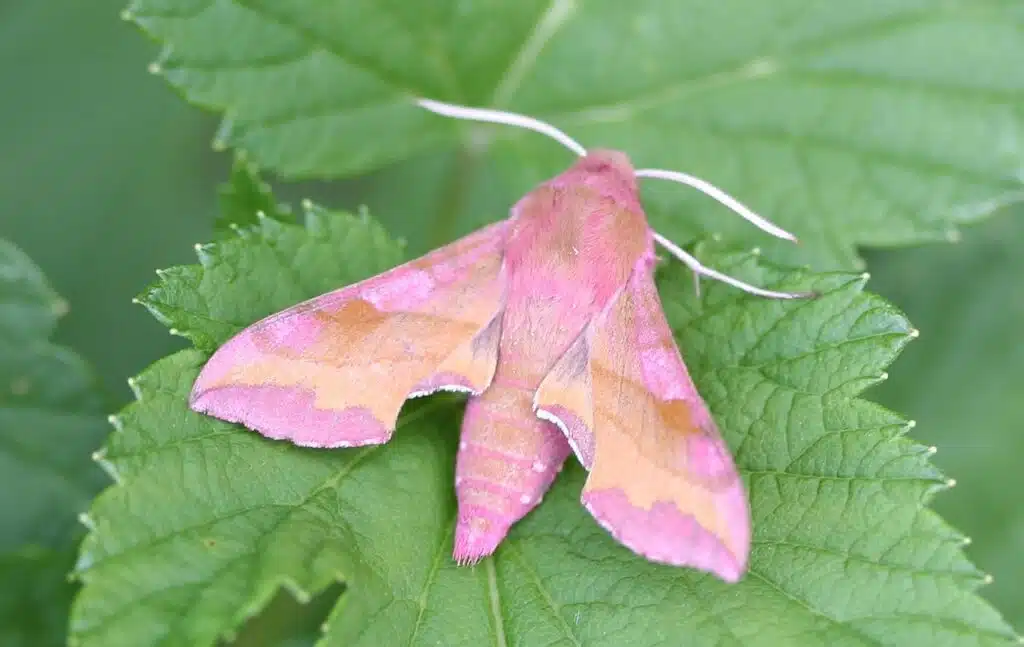
Native to Europe, Small Elephant Hawkmoths (Deilephila porcellus) have a wingspan of up to 2 inches.
These moths are mostly seen in coastal areas at low or high elevations of up to a few thousand feet.
This species has brown, yellow, and pink coloring.
Its largest pink sections are found on its body and the margins of its forewings and hindwings.
The species looks completely different as a caterpillar.
Small Elephant Hawkmoth caterpillars are mostly black. They have small and large pink eyespots.
These caterpillars exclusively feed on herbs. Their presence is numerous on meadows and in coastal areas.
10. Mint-loving Pyrausta Moth
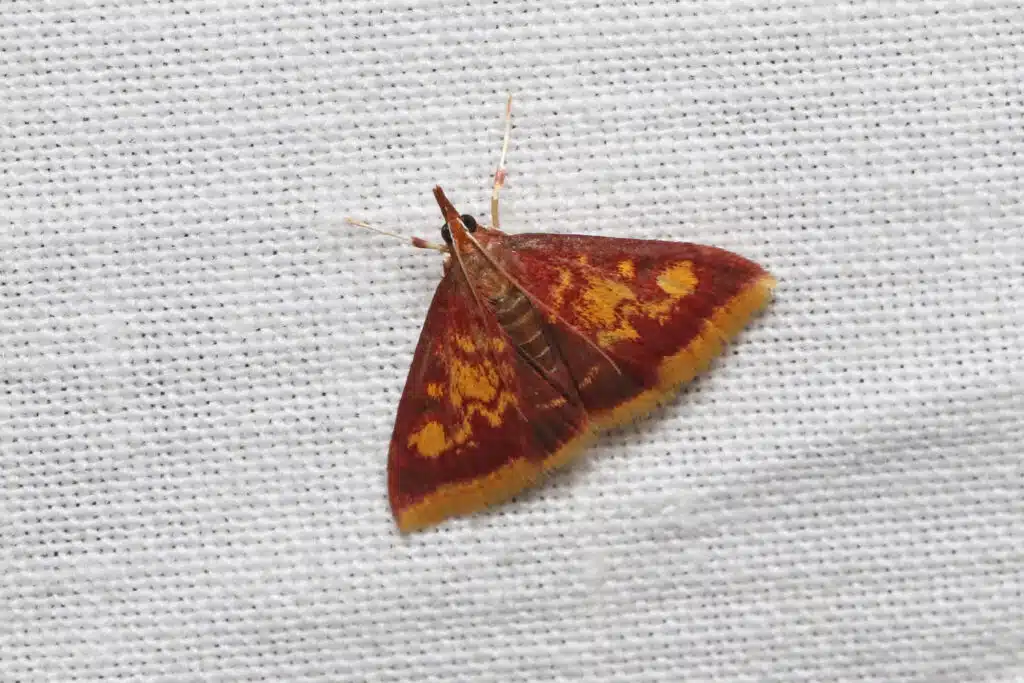
Mint-loving Pyrausta Moths (Pyrausta acrionalis) get their name from the mint plants their caterpillars consume.
Various types of wild mint are consumed by the caterpillar of the species while adults don’t eat at all.
The adult Mint-loving Pyrausta Moth has yellow and pink colors.
Darker yellow and darker pink sections are sink across its forewings.
This species has white legs.
Mint-loving Pyraista Moths are very small. They have an average wingspan between 14 and 15mm with 19mm being a maximum.
You can find this species in Georgia, New York, Alabama, and other Eastern US states.
11. Rosy-striped Knot-Horn
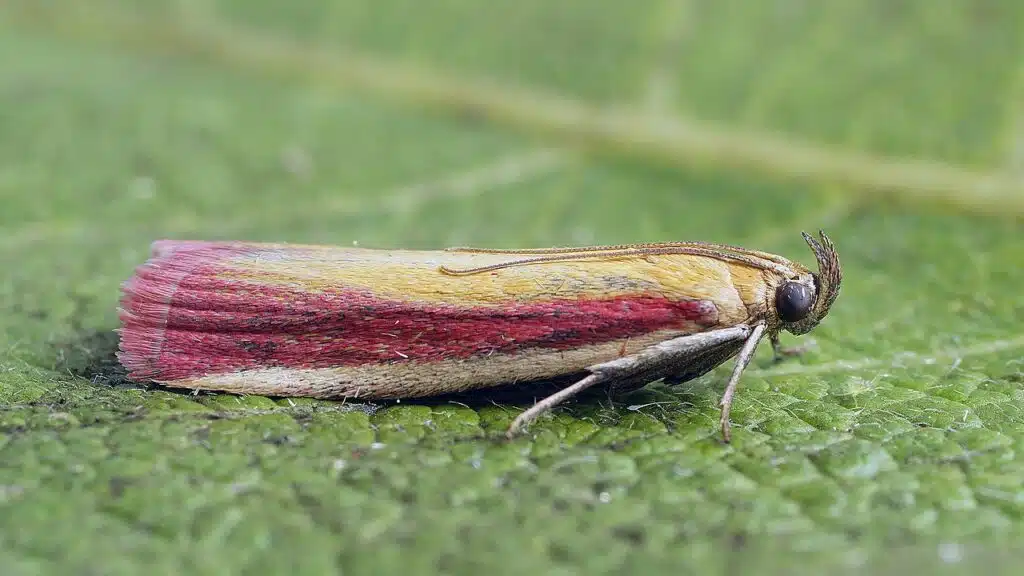
Rusty-striped Know-Horn moths (Oncocera semirubella) also prefer coastal areas. The species is mostly active between June and July as adults don’t eat.
This species of moths has pink forewings with light pink margins.
Its hindwings are green and gray. Both these colors have dark nuances contrasting its pink forewings.
This is one of the species of pink moths that only shows its pink and yellow forewings.
Its green and gray hindwings are only visible whenever the moth flies.
12. Common Crimson-and-gold Moth
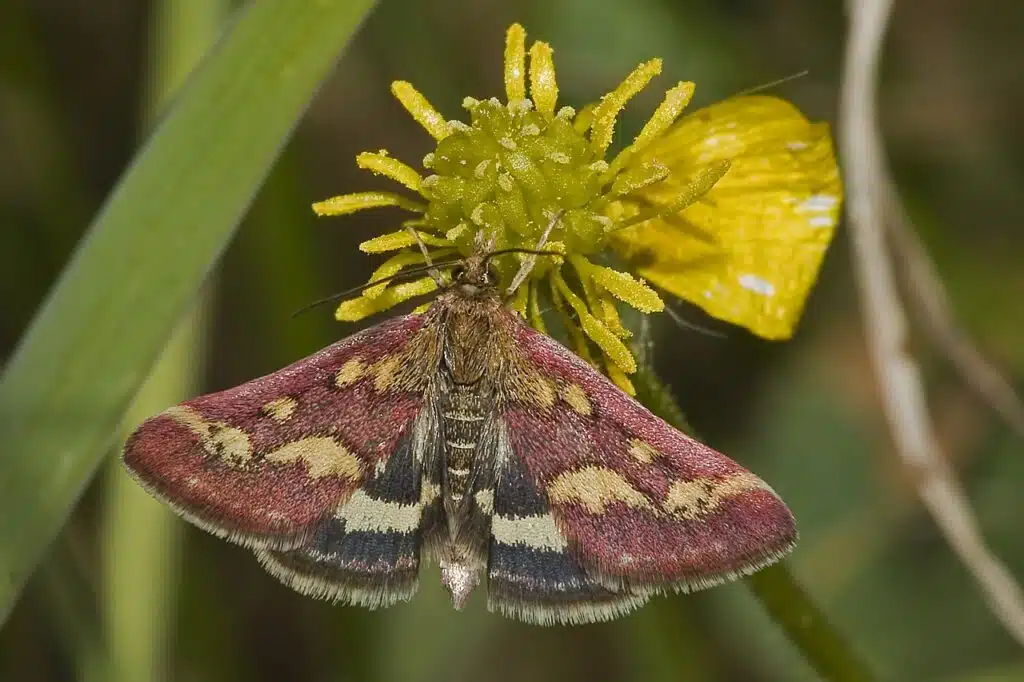
Common Crimson-and-gold Moths (Pyrausta purpuralis) have pink forewings. Yellow spots are seen on its forewings while its head is yellow and brown.
The hindwings of the species are brown, black, and yellow.
Ventral coloring of the species also shows pink, black, and yellow colors. Some morphs don’t have any pink coloring on the ventral wings.
This species has a small size as its wingspan can reach a maximum of 20mm in length.
Common Crimson-and-gold Moth caterpillars feed on all species of mint whole adults don’t feed at all.
13. Southern Purple Mint Moth
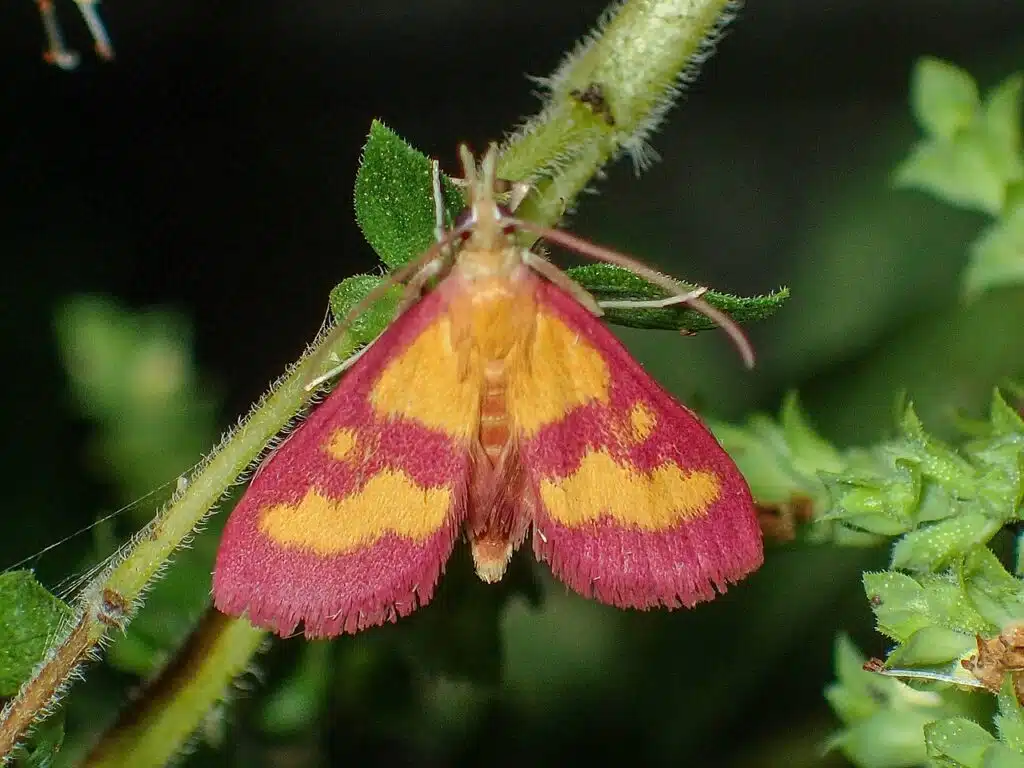
Rosemary and mint are among the favorite foods of the Southern Purple Mint Moth (Pyrausta laticlavia) caterpillar.
This species comes in many shades of pink. Bright pink is the most common morph of the moth.
Pink and yellow combinations are specific to its body and its forewings.
Some moths of the family have purple or dark pink coloring across the forewings and the body.
With a short wingspan, the species is seen around rosemary and mint herbs which it uses to lay eggs on.
Emerging larvae feed on these herbs until they pupate while adults aren’t known to eat.
You can identify the larvae of the Southern Purple Mint Moth by its shiny dark brown color.
14. Western Sheep Moth
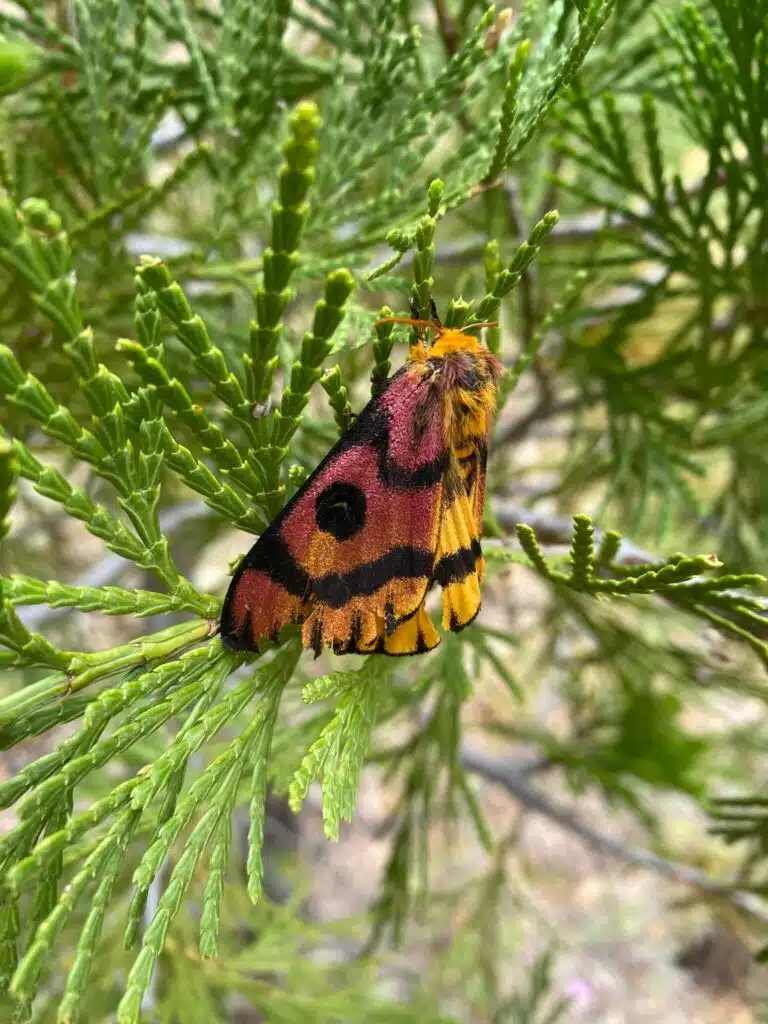
Western Sheep Moths (Hemileuca eglanterina) are only seen West of The Rocky Mountains.
This species has yellow, pink, and black colors.
Pink overlays are specific to the upper sections of its wings while the rest of its body and its hindwings are mostly yellow and black.
This moth is seen in multiple broods per year, mainly until September.
Adults don’t feed but caterpillars of Western Sheep Moths are seen on host plants they use for food such as bitter cherry and mountain lilac.
This is also one of the medium-sized pink moths in North America with an expected wingspan of up to 3 inches.
15. Southern Pink-striped Oakworm Moth
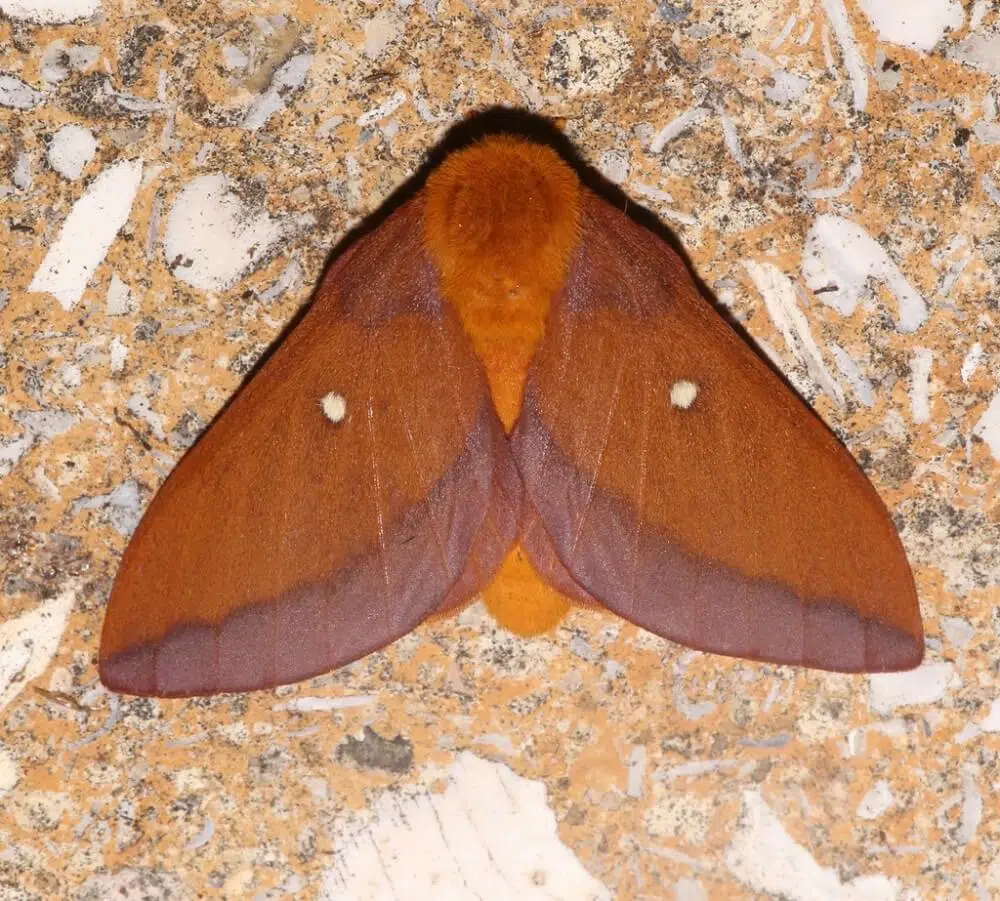
Southern Pink-striped Oakworm Moths (Anisota pellucida) are native to Southeastern and Eastern US.
This species has dark pink wings with transparent central sections.
Its body is mostly orange or orange-red.
Moths of this genus maintains some colors from their caterpillar stage. Southern Pink-striped Oakworm caterpillars are green with wide pink bands on the sides of the body.
This species can be detrimental to oak leaves to a high extent given it has the tendency to live in socially.
16. Clover Hayworm Moth
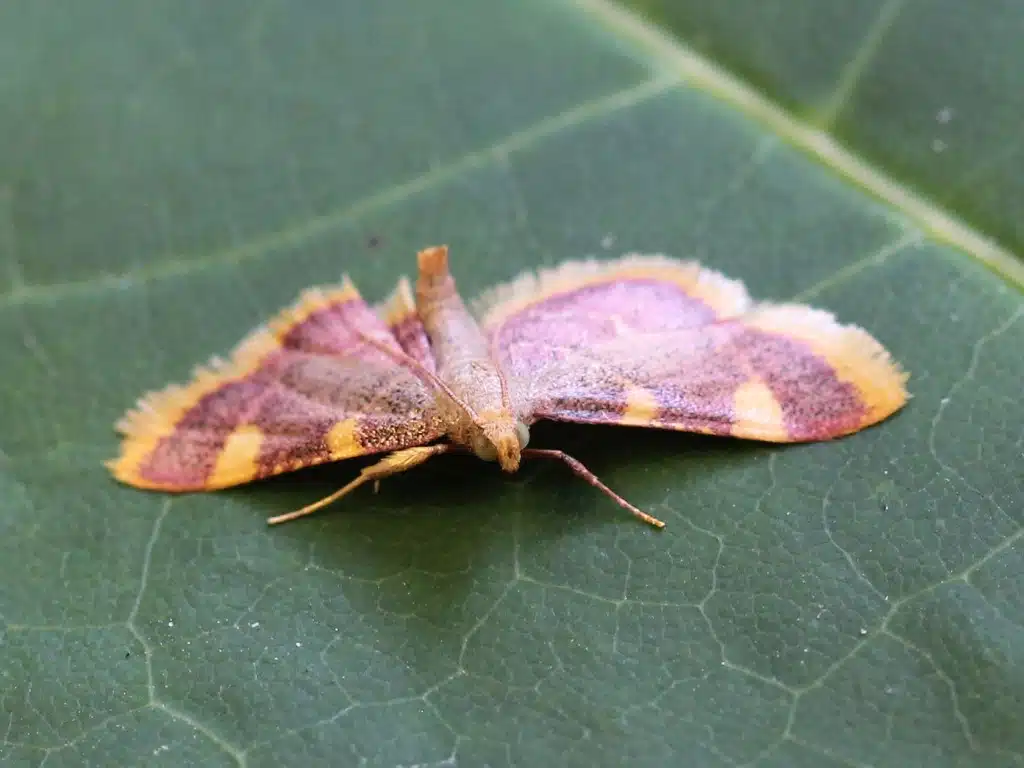
Clover Hayworm Moths (Hypsopygia costalis) are some of the most detrimental pink species.
The moth has a dark pink color with brown and yellow sections across the forewings. Its body is mostly brown and yellow.
Clover is negatively impacted by the caterpillar of the species.
This species tends to infest the nests of birds such as magpies. It’s also found in haystacks as hay is consumed by its caterpillars.
The high level of excrement makes haystacks unfit for purpose.
17. Bleeding Flower Moth
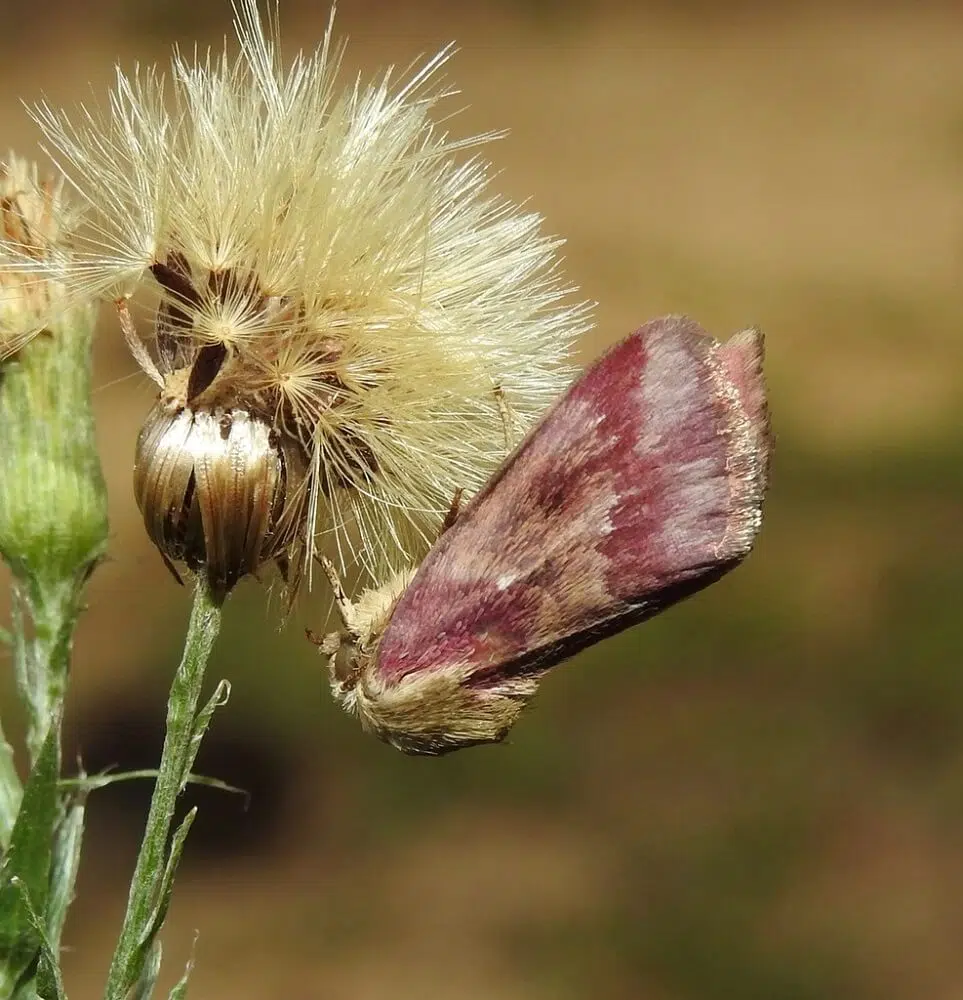
Bleeding Flower Moths (Schinia sanguinea) are some of the common bright pink species in the US.
These moths have bright pink forewings with only minimal white marks and white margins.
Brown and white dominate the hindwings which have no pink coloring at all. The body of the species is mostly brown and white.
Adult Bleeding Flower Moths don’t feed and only live for a month, typically up to October.
They grow to a maximum wingspan of up to 35mm.
The Bleeding Flower Moth caterpillar is exclusively found on blazing star flowers on meadows.
18. Spanish Moth
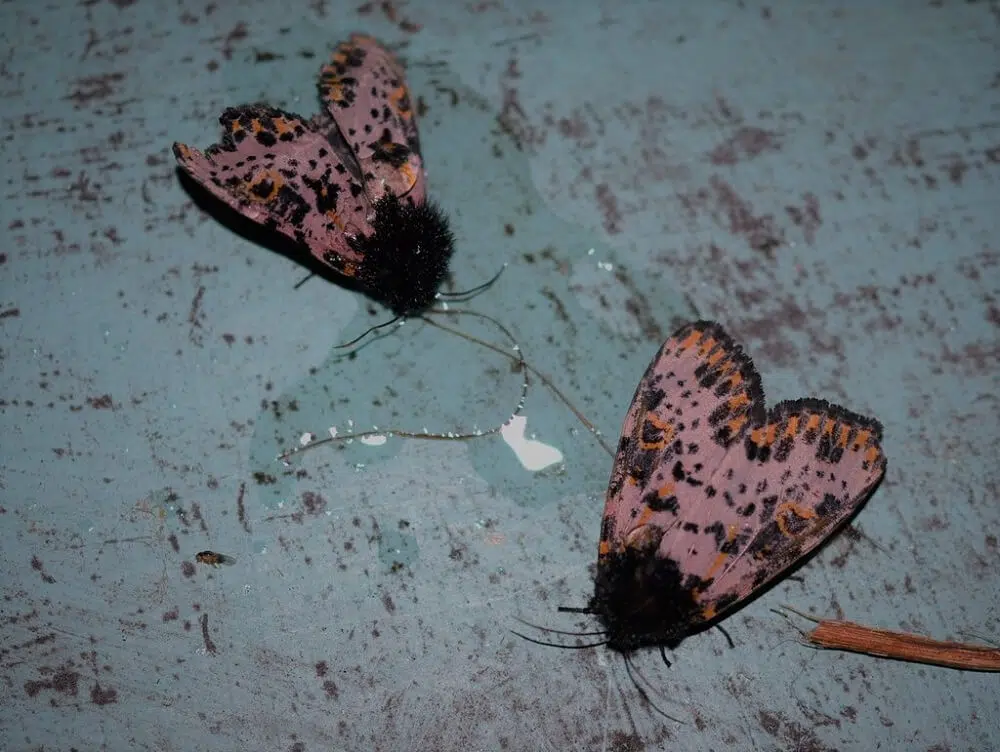
Lilies are among the most impacted species by the Spanish Moth (Xanthopastis Moctezuma). This species feeds on the leaves of lilies such as spider lilies.
Spanish Moths are among the most colorful pink species in the country. They have a high presence in Florida.
The species then becomes rarer in the Central and Western Coast states. Spanish moths still have a numerous presence in areas such as Southern Texas.
You can identify these moths by their pink forewings with brown and orange spots.
Its hindwings have a cream color without any pink areas. The body of the species is black and its upper body is known for having long black hairs with small white ends.